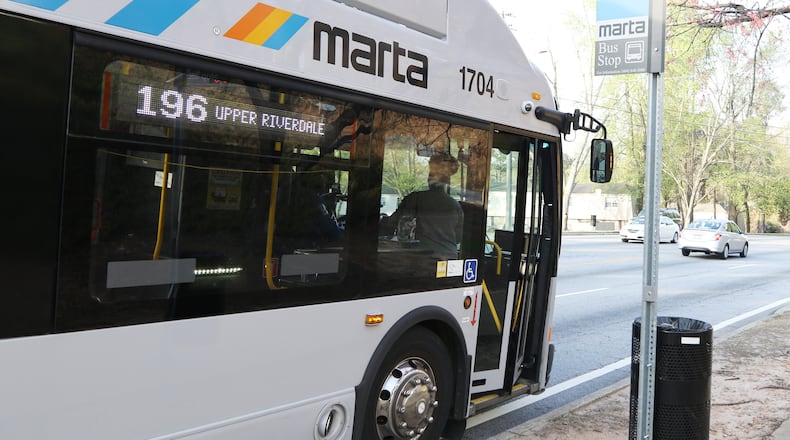With better safety equipment and other COVID-19 precautions in place, MARTA will begin collecting bus fares Monday for the first time in five months.
It’s a tentative step toward normalcy for a transit service disrupted by the coronavirus pandemic. But many metro Atlanta residents will still have a tough time catching buses to work, grocery stores and other destinations.
MARTA continues to operate less than half its bus routes as it focuses service on key corridors, and it has no timetable to restore most routes. The agency says it doesn’t have enough buses to provide safe service on all 110 of its regular routes amid the pandemic.
“It’s a choice between a managed, safer COVID environment and an unmanaged, unmitigated bus route, where you can get on the bus if you dare,” said Collie Greenwood, MARTA’s chief of bus operations.
But safety has come at a cost for many residents who depend on transit. They must walk longer distances to catch buses or pay higher fares to ride-hailing companies to get where they need to go.
“I need a break. I am paying most of my check in transportation,” said Tiffany Hutchinson, who rode Route 189 in the College Park area before it was cut. “When will all the buses be running? Things are getting tight.”
The pandemic has had a big impact on public transportation across metro Atlanta. Last spring many passengers disappeared as schools and businesses shut down and commuters worried about the safety of riding on packed trains and buses.
In January, federal statistics show passengers took more than 4.3 million trips on MARTA buses. By May, when ridership bottomed out, it was down 50%.
Local transit agencies cut service, stepped up cleaning of vehicles and stations, and took other steps to protect passengers and drivers.
In March MARTA suspended bus fares and began boarding passengers at the rear door to separate them from drivers. In April the agency eliminated 70 of its 110 routes and added one route. The idea was to double the frequency of buses on the remaining routes to spread passengers over more buses and reduce crowding.
The move prompted a lawsuit that claims MARTA CEO Jeffrey Parker did not have the authority to cut the routes without public input or a vote by the MARTA board. MARTA says the CEO has the authority to take such emergency measures. The lawsuit is pending in Fulton County Superior Court.
MARTA now requires passengers to wear masks and gives away masks to those who don’t have them. It has installed polycarbonate shields for drivers on its 539 buses, as well as antimicrobial air filters and mask dispensers.
These and other expenses come as sales tax and fare revenue have plummeted. MARTA set aside $20 million in a contingency fund to pay for COVID-related expenses this year. It’s also using $150 million in federal aid to balance its $558 million operating budget.
But with safety measures in place, MARTA plans to resume fare collection and front-door boarding Monday.
As Georgia’s economy has gradually reopened, MARTA ridership has also rebounded. On Thursday, bus ridership was down just 25% from an average weekday in February, the agency says.
Some of those missing passengers may be sheltering at home or otherwise choosing not to be out and about — traffic on local highways is still down about 15%, according to the Georgia Department of Transportation. But there are plenty of people who want to ride the bus but can’t.
Beth Perry of Atlanta used to catch a MARTA bus to work from a stop just a block from her apartment. But the two bus routes she relied on have both been cut.
She could walk four blocks to another stop and catch a ride to West End station. From there, she could catch a train to Ashby station, then walk another five blocks to work. But she said a stomach hernia makes it hard for her to walk long distances.
Perry said she cut back her hours at work and used Lyft to get there. But some days she paid more than $25 round-trip to make $50 at work. Before, she paid MARTA fares of just $25 a week.
“My income has been drastically cut by not being able to get to work and having this extra expense added for alternative transportation,” Perry said. “I don’t really think MARTA understands just how critical these buses are for low-income riders.”
Raynard Johnson of Atlanta used to catch a bus right outside his house. Now he walks at least a mile and a half to the nearest stop. That makes it hard to get groceries, do laundry and run other errands.
Johnson doesn’t think MARTA should collect full fares until it restores full service.
“If you’re going to charge me full fare but only give me 37% of the routes, that doesn’t sound equitable to me,” he said.
MARTA has restored six routes since April. And it plans to restore two more — Routes 12 and 116 — on Sept. 26. But Greenwood said there simply aren’t enough buses to provide the frequent service needed for social distancing on all its routes.
Greenwood said MARTA understands the importance of bus service to low-income residents. He said the agency reduced service on some routes so it could restore the routes it has added to date. But he said the agency needs the pandemic to subside more before it can safely restore full service.
“The masks, the ridership, they’re all heading in the right direction,” he said. “But I think the state infection rate is probably the largest determining factor.
“I know our current numbers are no better than they were when the orders (to cut routes) were issued.”
About the Author
Featured


